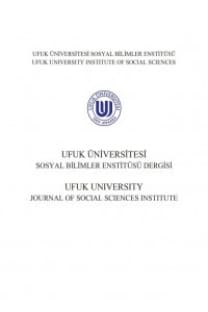Ufuk Üniversitesi Hazırlık Okulunda Devam ve İngilizce Başarısı Arasındaki İlişki
Derse Devam, Başarı, Cinsiyet, Yaş, Öğrencilerin Anadalları, Yüksek Öğretim
THE RELATIONSHIP BETWEEN ATTENDANCE AND ENGLISH ACHIEVEMENT AT UFUK UNIVERSITY PREPARATORY SCHOOL
Class Attendance, Success, Gender, Age, Student Majors, Higher Education,
___
- Bahar, M. (2015). Relationship among language tests, portfolio, participation, absence, and later academic achievement at higher education. International Journal on New Trends in Education and Their Implications, 6(2), 187-195.
- Becker, B. (2010). Wer profitiert mehr vomKindergarten? Die Wirkung der Kindergartenbesuchsdauer und Ausstattungsqualität auf die Entwicklung des deutschen Wortschatzes bei deutschen und türkischen Kindern. Kolner Zeitschrift Fur Soziologie und Sozialpsycholgie 62 (1), 139-163.
- Berenson, S.B., Carter, G. and Norwood, K.S. (1992) “The At-Risk Student in College Developmental Algebra.” School Science and Mathematics, 92(2), 55-58
- Condelli, L., Wrigley, H., Yoon, S., Cronen, S., & Seburn, M. (2002). Final report: What Works study for adult ESL literacy students. Washington, DC: Planning and Evaluation Service, U.S. Department of Education.
- Fay, R. E., Aguirre, R. V., & Gash, P. W. (2013). Absenteeism and language learning: does missing class matter? Journal of Language Teaching and Research, 4(6), 1184– 1190.
- Gottfried, M. A. (2009). Evaluating the relationship between student attendance and achievement in urban elementary and middle schools: An instrumental variables approach. American Educational Research Journal, 47(2), 1-32.
- Gump, S.E. (2005), “The Cost of Cutting Class: Attendance as a Predictor of Success”. College Teaching, Vol. 53 No. 1, pp. 21-26.
- Halpern, N. (2007), “The Impact of Attendance and Student Characteristics on Academic Achievement: Findings from an Undergraduate Business Management Module”, Journal of Further & Higher Education, Vol. 31 No. 4, pp. 335-349.
- Hubbs-Tait, L., Culp, A.M., Erron, H., Culp, R., Starost, H., & Hare, C. (2002). Relation of Head Start attendance to children’s cognitive and social outcomes: Moderation by family risk. Early Childhood Research Quarterly, 17, 539-558.
- Kelsen, B.A. and Liang, H. (2012). Indicators of Achievement in EFL Classes at a Taiwanese University. Education Research International, Vol. 2012.
- Lamdin, D. J. (1996). Student Attendance as an Independent Variable in Education Production Functions: Evidence from Baltimore Public Elementary Schools. Journal of Educational Research, 1996, 5, 155-162.
- Marburger, D.R. (2006). Does mandatory attendance improve student performance?, Journal of Economic Education, 37 (2): 148-155.
- Moore, R., Jensen, M., Hatch, J., Duranczyk, I., Staats, S. and Koch, L. (2003) “Showing Up: The Importance of Class Attendance for Academic Success in Introductory Science Courses.” The American Biology Teacher, 65(5): 325-329
- Morrissey, W., Hutchison, L. & Winsler, A., (2014). Family income, school attendance, and academic achievement in elementary school. Developmental Psychology, American Psychological Association, 50(3), 741– 753.
- Newman-Ford, L., Fitzgibbon, K., Lloyd, S. and Thomas, S. (2008), “A large-scale investigation into the relationship between attendance and attainment: a study using an innovative, electronic attendance monitoring system”, Studies in Higher Education, Vol. 33 No. 6, pp. 699-717.
- Nichols, J. D. (2003). Prediction indicators for students failing the state of Indiana high school graduation exam. Preventing School Failure, 47, 112–120.
- Özkanal, Ü. and Arıkan, N. (2011). The relation between success and absenteeism at Esogu English Preparatory School. Journal of Language Teaching and Research, 2(1), 68-72.
- Roby, D. E. (2004). Research on school attendance and student achievement: A study of Ohio schools. Educational Research Quarterly, 28, 3–14.
- Sawyer, R., Gibson, N. (2012). Exploratory Analyses of the Long-Term Effects of Improving Behavior, Attendance, and Educational Achievement in Grades 1-6 and 8- 12. ACT Research Report Series, (3).
- Siciliano, E.A. (1978). Absenteeism and Language Learning. Hispania, Vol. 61, No. 1, pp. 102-104.
- Spradlin, T., Cierniak, K., Shi, D., & Chen, M. (2012). Attendance and chronic absenteeism in Indiana: The impact on student achievement. Education Policy Brief, 10(3), Summer 2012. Center for Evaluation and Education Policy, Indiana University.
- Torenbeek, M., Jansen, E. & Suhre, C. (2013). Predicting undergraduates' academic achievement: the role of the curriculum, time investment and self-regulated learning. Studies in Higher Education, 38(9), 1393-1406
- Wigley, S. C. (2009). The relationship between attendance and academic performance in further education college A/S psychology students. Journal of Further and Higher Education. 33 (2).
- Woodfield, R., Jessop, D. & McMillan, L. (2006), “Gender differences in undergraduate attendance rates”, Studies in Higher Education, Vol. 31 No. 1, pp. 1-22.
- ISSN: 2146-7676
- Başlangıç: 2011
- Yayıncı: Ufuk Üniversitesi
BİLİŞSEL ŞEMALARDA CİNSİYET FARKI
DÖVİZ KURU ENFLASYON İLİŞKİSİ “TÜRKİYE ÖRNEĞİ”
Neşe (IŞIK)TERTEMİZ, Selma ASLANTAŞ
Ufuk Üniversitesi Hazırlık Okulunda Devam ve İngilizce Başarısı Arasındaki İlişki
Direniş ve Karşı Direniş Harekatı Örneği Olarak: Afganistan
Avrupa Birliği AB Gümrük Birliği’nin Türkiye Ekonomisine Etkileri
